Resource Allocation Plan and Strategic Risk Analysis for McDonald's
VerifiedAdded on 2023/01/18
|16
|3730
|92
Report
AI Summary
This report provides an in-depth analysis of McDonald's operations management, focusing on resource allocation and strategic risk assessment. It begins with an introduction to operations management and its importance, followed by a detailed resource allocation plan covering human resources, financial resources, quality technology, and transportation logistics. The report then discusses strategies for supporting the resource allocation plan, including training and development, capital budgeting, total quality management, and just-in-time inventory management. Furthermore, it applies the Resource-Based View (RBV) and VRIO model to assess McDonald's resources and competitive advantages. The McKinsey's 7S model is also used to analyze the company's design and key elements. The report concludes by highlighting the key findings and implications for McDonald's operational success.
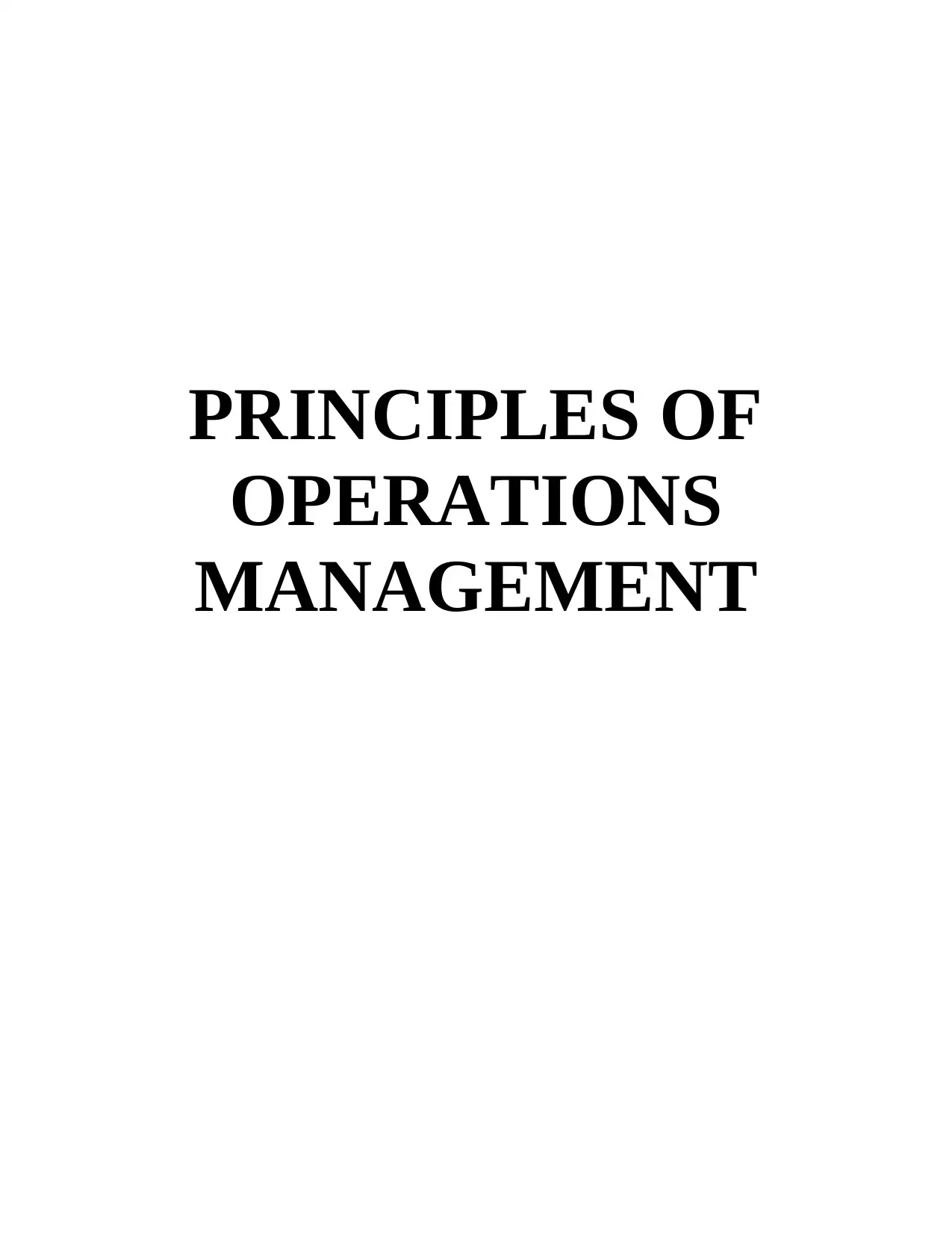
PRINCIPLES OF
OPERATIONS
MANAGEMENT
OPERATIONS
MANAGEMENT
Paraphrase This Document
Need a fresh take? Get an instant paraphrase of this document with our AI Paraphraser

Table of Contents
INTRODUCTION...........................................................................................................................1
TASK 3............................................................................................................................................1
P7. Preparation of a Resource Allocation Plan......................................................................1
TASK 4............................................................................................................................................5
P8. Devising and Carrying out an SRA for McDonald's........................................................5
CONCLUSION................................................................................................................................8
REFERENCES..............................................................................................................................10
INTRODUCTION...........................................................................................................................1
TASK 3............................................................................................................................................1
P7. Preparation of a Resource Allocation Plan......................................................................1
TASK 4............................................................................................................................................5
P8. Devising and Carrying out an SRA for McDonald's........................................................5
CONCLUSION................................................................................................................................8
REFERENCES..............................................................................................................................10
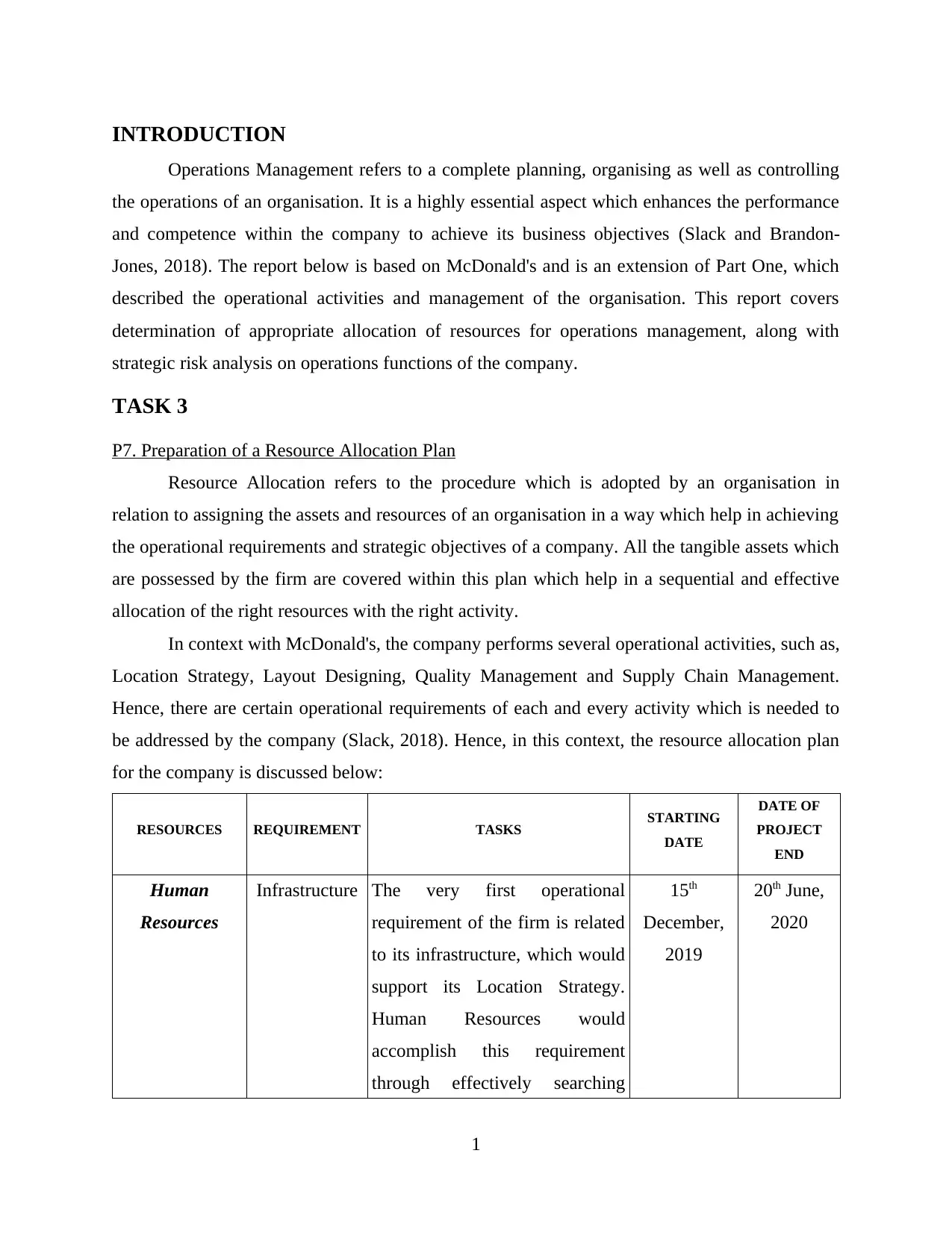
INTRODUCTION
Operations Management refers to a complete planning, organising as well as controlling
the operations of an organisation. It is a highly essential aspect which enhances the performance
and competence within the company to achieve its business objectives (Slack and Brandon-
Jones, 2018). The report below is based on McDonald's and is an extension of Part One, which
described the operational activities and management of the organisation. This report covers
determination of appropriate allocation of resources for operations management, along with
strategic risk analysis on operations functions of the company.
TASK 3
P7. Preparation of a Resource Allocation Plan
Resource Allocation refers to the procedure which is adopted by an organisation in
relation to assigning the assets and resources of an organisation in a way which help in achieving
the operational requirements and strategic objectives of a company. All the tangible assets which
are possessed by the firm are covered within this plan which help in a sequential and effective
allocation of the right resources with the right activity.
In context with McDonald's, the company performs several operational activities, such as,
Location Strategy, Layout Designing, Quality Management and Supply Chain Management.
Hence, there are certain operational requirements of each and every activity which is needed to
be addressed by the company (Slack, 2018). Hence, in this context, the resource allocation plan
for the company is discussed below:
RESOURCES REQUIREMENT TASKS STARTING
DATE
DATE OF
PROJECT
END
Human
Resources
Infrastructure The very first operational
requirement of the firm is related
to its infrastructure, which would
support its Location Strategy.
Human Resources would
accomplish this requirement
through effectively searching
15th
December,
2019
20th June,
2020
1
Operations Management refers to a complete planning, organising as well as controlling
the operations of an organisation. It is a highly essential aspect which enhances the performance
and competence within the company to achieve its business objectives (Slack and Brandon-
Jones, 2018). The report below is based on McDonald's and is an extension of Part One, which
described the operational activities and management of the organisation. This report covers
determination of appropriate allocation of resources for operations management, along with
strategic risk analysis on operations functions of the company.
TASK 3
P7. Preparation of a Resource Allocation Plan
Resource Allocation refers to the procedure which is adopted by an organisation in
relation to assigning the assets and resources of an organisation in a way which help in achieving
the operational requirements and strategic objectives of a company. All the tangible assets which
are possessed by the firm are covered within this plan which help in a sequential and effective
allocation of the right resources with the right activity.
In context with McDonald's, the company performs several operational activities, such as,
Location Strategy, Layout Designing, Quality Management and Supply Chain Management.
Hence, there are certain operational requirements of each and every activity which is needed to
be addressed by the company (Slack, 2018). Hence, in this context, the resource allocation plan
for the company is discussed below:
RESOURCES REQUIREMENT TASKS STARTING
DATE
DATE OF
PROJECT
END
Human
Resources
Infrastructure The very first operational
requirement of the firm is related
to its infrastructure, which would
support its Location Strategy.
Human Resources would
accomplish this requirement
through effectively searching
15th
December,
2019
20th June,
2020
1
⊘ This is a preview!⊘
Do you want full access?
Subscribe today to unlock all pages.

Trusted by 1+ million students worldwide
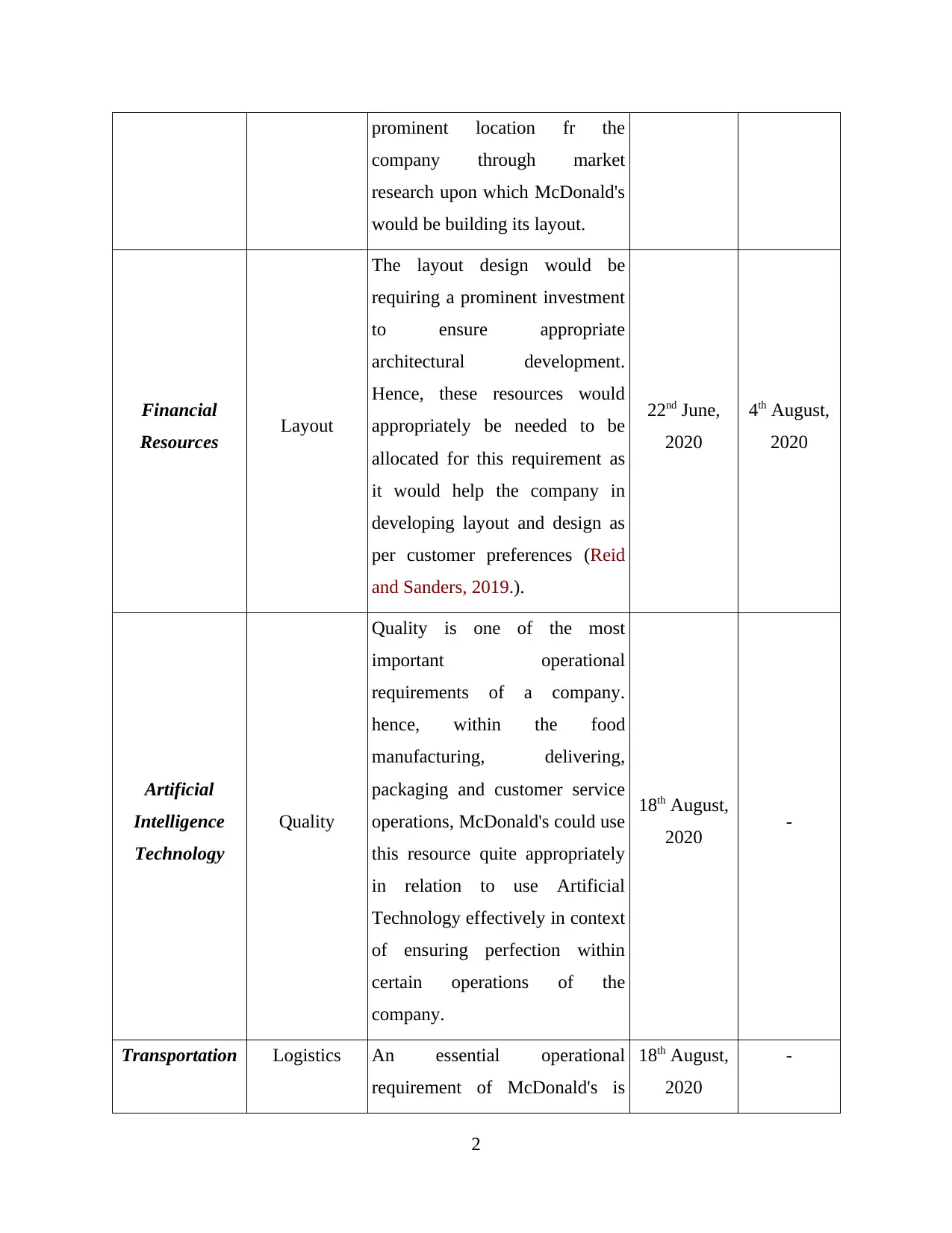
prominent location fr the
company through market
research upon which McDonald's
would be building its layout.
Financial
Resources Layout
The layout design would be
requiring a prominent investment
to ensure appropriate
architectural development.
Hence, these resources would
appropriately be needed to be
allocated for this requirement as
it would help the company in
developing layout and design as
per customer preferences (Reid
and Sanders, 2019.).
22nd June,
2020
4th August,
2020
Artificial
Intelligence
Technology
Quality
Quality is one of the most
important operational
requirements of a company.
hence, within the food
manufacturing, delivering,
packaging and customer service
operations, McDonald's could use
this resource quite appropriately
in relation to use Artificial
Technology effectively in context
of ensuring perfection within
certain operations of the
company.
18th August,
2020 -
Transportation Logistics An essential operational
requirement of McDonald's is
18th August,
2020
-
2
company through market
research upon which McDonald's
would be building its layout.
Financial
Resources Layout
The layout design would be
requiring a prominent investment
to ensure appropriate
architectural development.
Hence, these resources would
appropriately be needed to be
allocated for this requirement as
it would help the company in
developing layout and design as
per customer preferences (Reid
and Sanders, 2019.).
22nd June,
2020
4th August,
2020
Artificial
Intelligence
Technology
Quality
Quality is one of the most
important operational
requirements of a company.
hence, within the food
manufacturing, delivering,
packaging and customer service
operations, McDonald's could use
this resource quite appropriately
in relation to use Artificial
Technology effectively in context
of ensuring perfection within
certain operations of the
company.
18th August,
2020 -
Transportation Logistics An essential operational
requirement of McDonald's is
18th August,
2020
-
2
Paraphrase This Document
Need a fresh take? Get an instant paraphrase of this document with our AI Paraphraser
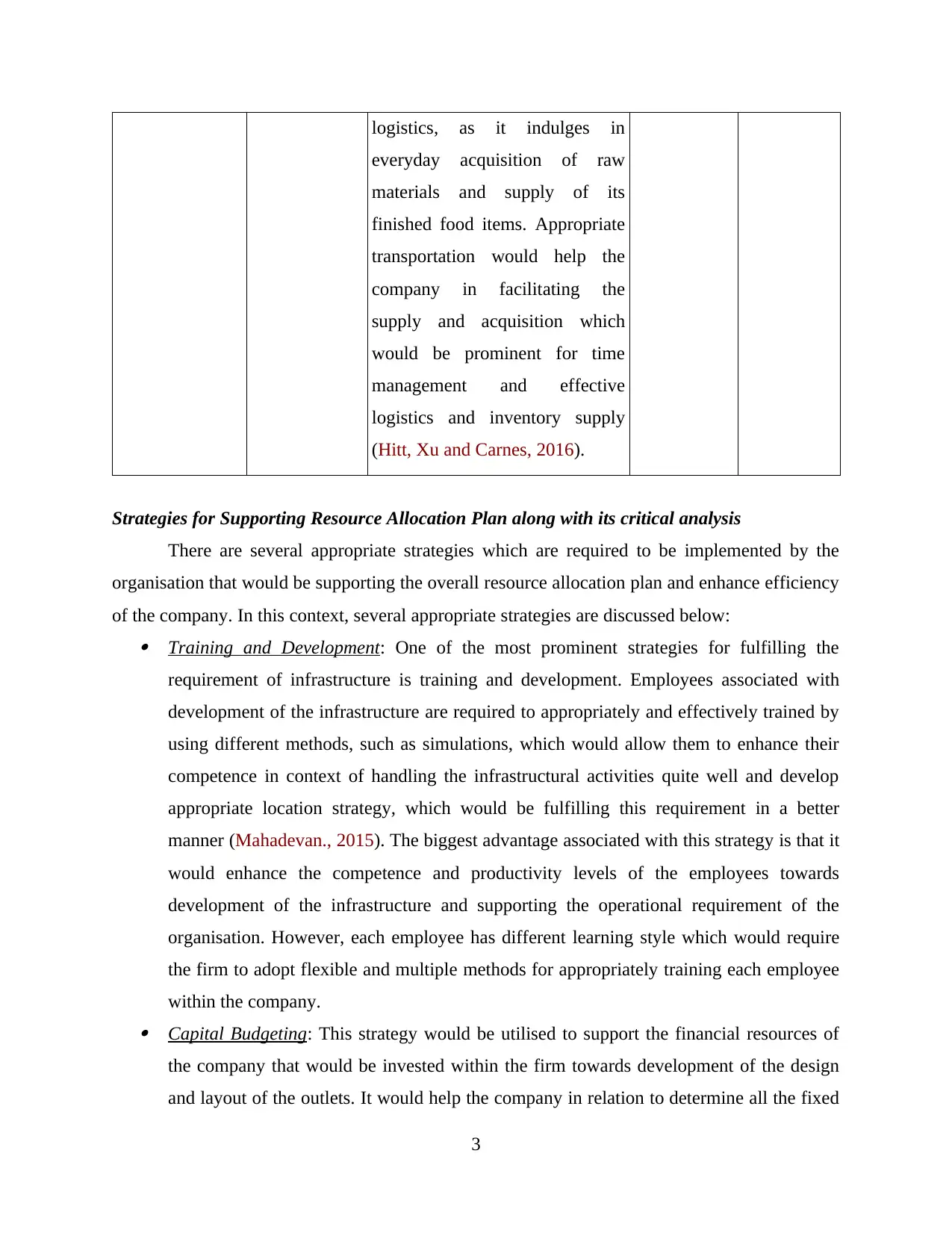
logistics, as it indulges in
everyday acquisition of raw
materials and supply of its
finished food items. Appropriate
transportation would help the
company in facilitating the
supply and acquisition which
would be prominent for time
management and effective
logistics and inventory supply
(Hitt, Xu and Carnes, 2016).
Strategies for Supporting Resource Allocation Plan along with its critical analysis
There are several appropriate strategies which are required to be implemented by the
organisation that would be supporting the overall resource allocation plan and enhance efficiency
of the company. In this context, several appropriate strategies are discussed below: Training and Development: One of the most prominent strategies for fulfilling the
requirement of infrastructure is training and development. Employees associated with
development of the infrastructure are required to appropriately and effectively trained by
using different methods, such as simulations, which would allow them to enhance their
competence in context of handling the infrastructural activities quite well and develop
appropriate location strategy, which would be fulfilling this requirement in a better
manner (Mahadevan., 2015). The biggest advantage associated with this strategy is that it
would enhance the competence and productivity levels of the employees towards
development of the infrastructure and supporting the operational requirement of the
organisation. However, each employee has different learning style which would require
the firm to adopt flexible and multiple methods for appropriately training each employee
within the company. Capital Budgeting: This strategy would be utilised to support the financial resources of
the company that would be invested within the firm towards development of the design
and layout of the outlets. It would help the company in relation to determine all the fixed
3
everyday acquisition of raw
materials and supply of its
finished food items. Appropriate
transportation would help the
company in facilitating the
supply and acquisition which
would be prominent for time
management and effective
logistics and inventory supply
(Hitt, Xu and Carnes, 2016).
Strategies for Supporting Resource Allocation Plan along with its critical analysis
There are several appropriate strategies which are required to be implemented by the
organisation that would be supporting the overall resource allocation plan and enhance efficiency
of the company. In this context, several appropriate strategies are discussed below: Training and Development: One of the most prominent strategies for fulfilling the
requirement of infrastructure is training and development. Employees associated with
development of the infrastructure are required to appropriately and effectively trained by
using different methods, such as simulations, which would allow them to enhance their
competence in context of handling the infrastructural activities quite well and develop
appropriate location strategy, which would be fulfilling this requirement in a better
manner (Mahadevan., 2015). The biggest advantage associated with this strategy is that it
would enhance the competence and productivity levels of the employees towards
development of the infrastructure and supporting the operational requirement of the
organisation. However, each employee has different learning style which would require
the firm to adopt flexible and multiple methods for appropriately training each employee
within the company. Capital Budgeting: This strategy would be utilised to support the financial resources of
the company that would be invested within the firm towards development of the design
and layout of the outlets. It would help the company in relation to determine all the fixed
3

assets that must be purchased by the firm, such as its logo, product development
machinery, etc., and which assets are required to be declined by the company. which
would further assist the firm in taking smart investment decisions. Its biggest advantage
is that all the risk involved in investment opportunity is quite effectively analysed by this
method which allows the company to take calculative decisions related to layout and
design. However, assessment of such risk could lead to several wrong application of the
investment decision due to inappropriate analysis. Hence, in relation to adopt this strategy
appropriately, risks must be assessed internally at first and then decisions must be taken
in relation to design and layout (Hosseinian-Far, Ramachandran and Slack, 2018). Total Quality Management: This strategy must be adopted by the firm while the
organisation fulfils the requirement of quality management. This technique focuses on
adopting methods and processes that keep up the consistency of the firm where the
quality is concerned. One of the biggest advantages of the company is that it helps them
deliver quality products and services to the customers which is a core requirement of the
firm. However, there could be chances where the company could adopt methods,
equipments or techniques that incur high end costs for the organisation, which could be
disadvantageous for its other operations that are dependent on its monetary support.
Hence, in order to appropriately use the same, the firm must first evaluate the alternatives
in terms of both cost and quality and then must acquire resources that are both cost
effective and quality assured. Just-In-Time Inventory Management: In this inventory management technique,
McDonald's would be undertaking the supply as per the order. This would be supporting
logistics requirement of the organisation through including the quantity that would be
required by the firm at the end of the day, which would save time and efforts of
channelising more transportation channels. Its advantage relates with the fact that it helps
the firm in cutting down the cost and ensure effective relations with its supply chain
management. However, the demerit of this method is that since McDonald's is a fast food
outlet, it is not necessary that only set quantities would be used, as it could have
spontaneous demand throughout the day or weekends. Hence, the firm must adopt certain
effective techniques which appropriately and effectively ensure appropriate stock level to
4
machinery, etc., and which assets are required to be declined by the company. which
would further assist the firm in taking smart investment decisions. Its biggest advantage
is that all the risk involved in investment opportunity is quite effectively analysed by this
method which allows the company to take calculative decisions related to layout and
design. However, assessment of such risk could lead to several wrong application of the
investment decision due to inappropriate analysis. Hence, in relation to adopt this strategy
appropriately, risks must be assessed internally at first and then decisions must be taken
in relation to design and layout (Hosseinian-Far, Ramachandran and Slack, 2018). Total Quality Management: This strategy must be adopted by the firm while the
organisation fulfils the requirement of quality management. This technique focuses on
adopting methods and processes that keep up the consistency of the firm where the
quality is concerned. One of the biggest advantages of the company is that it helps them
deliver quality products and services to the customers which is a core requirement of the
firm. However, there could be chances where the company could adopt methods,
equipments or techniques that incur high end costs for the organisation, which could be
disadvantageous for its other operations that are dependent on its monetary support.
Hence, in order to appropriately use the same, the firm must first evaluate the alternatives
in terms of both cost and quality and then must acquire resources that are both cost
effective and quality assured. Just-In-Time Inventory Management: In this inventory management technique,
McDonald's would be undertaking the supply as per the order. This would be supporting
logistics requirement of the organisation through including the quantity that would be
required by the firm at the end of the day, which would save time and efforts of
channelising more transportation channels. Its advantage relates with the fact that it helps
the firm in cutting down the cost and ensure effective relations with its supply chain
management. However, the demerit of this method is that since McDonald's is a fast food
outlet, it is not necessary that only set quantities would be used, as it could have
spontaneous demand throughout the day or weekends. Hence, the firm must adopt certain
effective techniques which appropriately and effectively ensure appropriate stock level to
4
⊘ This is a preview!⊘
Do you want full access?
Subscribe today to unlock all pages.

Trusted by 1+ million students worldwide
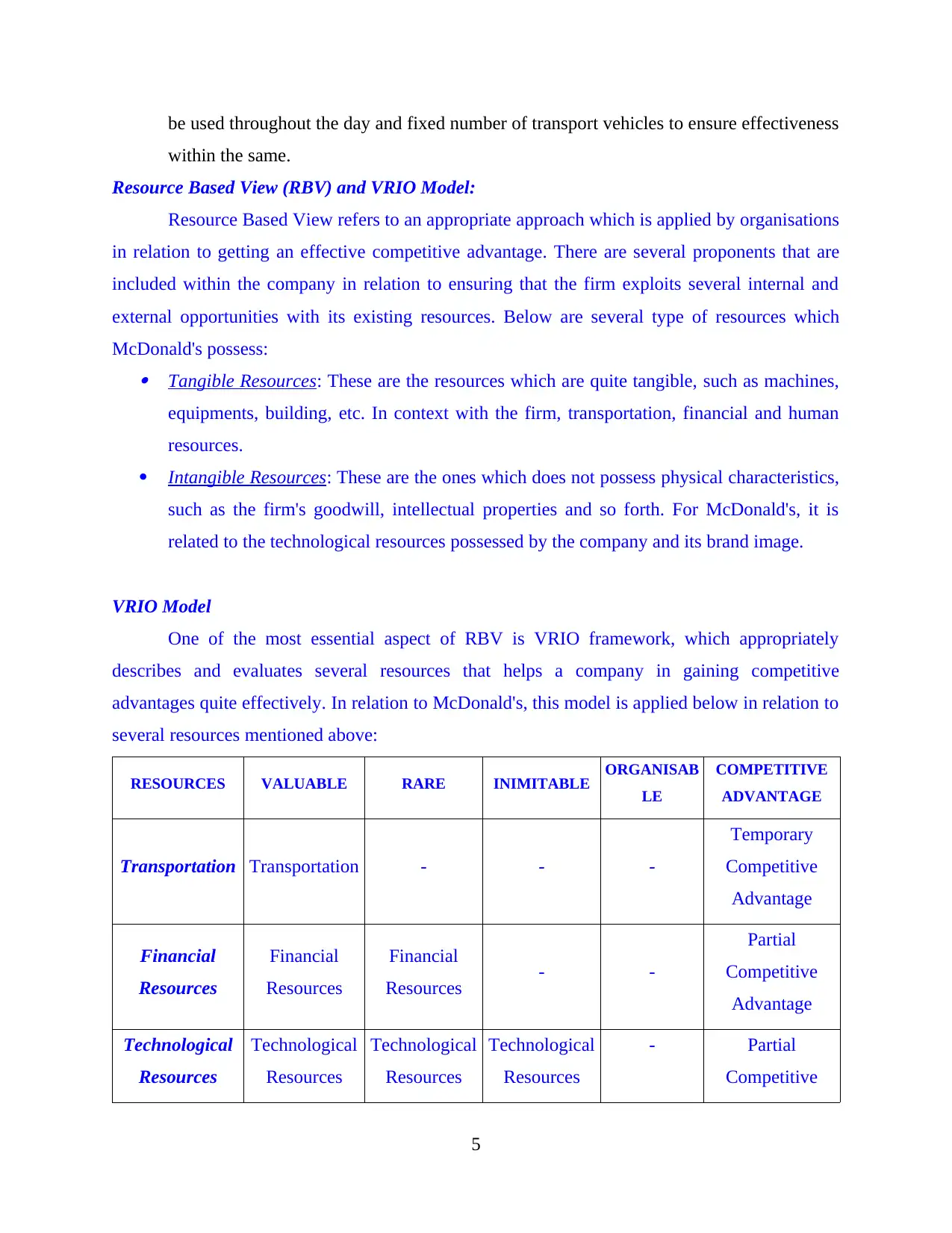
be used throughout the day and fixed number of transport vehicles to ensure effectiveness
within the same.
Resource Based View (RBV) and VRIO Model:
Resource Based View refers to an appropriate approach which is applied by organisations
in relation to getting an effective competitive advantage. There are several proponents that are
included within the company in relation to ensuring that the firm exploits several internal and
external opportunities with its existing resources. Below are several type of resources which
McDonald's possess: Tangible Resources: These are the resources which are quite tangible, such as machines,
equipments, building, etc. In context with the firm, transportation, financial and human
resources.
Intangible Resources: These are the ones which does not possess physical characteristics,
such as the firm's goodwill, intellectual properties and so forth. For McDonald's, it is
related to the technological resources possessed by the company and its brand image.
VRIO Model
One of the most essential aspect of RBV is VRIO framework, which appropriately
describes and evaluates several resources that helps a company in gaining competitive
advantages quite effectively. In relation to McDonald's, this model is applied below in relation to
several resources mentioned above:
RESOURCES VALUABLE RARE INIMITABLE ORGANISAB
LE
COMPETITIVE
ADVANTAGE
Transportation Transportation - - -
Temporary
Competitive
Advantage
Financial
Resources
Financial
Resources
Financial
Resources - -
Partial
Competitive
Advantage
Technological
Resources
Technological
Resources
Technological
Resources
Technological
Resources
- Partial
Competitive
5
within the same.
Resource Based View (RBV) and VRIO Model:
Resource Based View refers to an appropriate approach which is applied by organisations
in relation to getting an effective competitive advantage. There are several proponents that are
included within the company in relation to ensuring that the firm exploits several internal and
external opportunities with its existing resources. Below are several type of resources which
McDonald's possess: Tangible Resources: These are the resources which are quite tangible, such as machines,
equipments, building, etc. In context with the firm, transportation, financial and human
resources.
Intangible Resources: These are the ones which does not possess physical characteristics,
such as the firm's goodwill, intellectual properties and so forth. For McDonald's, it is
related to the technological resources possessed by the company and its brand image.
VRIO Model
One of the most essential aspect of RBV is VRIO framework, which appropriately
describes and evaluates several resources that helps a company in gaining competitive
advantages quite effectively. In relation to McDonald's, this model is applied below in relation to
several resources mentioned above:
RESOURCES VALUABLE RARE INIMITABLE ORGANISAB
LE
COMPETITIVE
ADVANTAGE
Transportation Transportation - - -
Temporary
Competitive
Advantage
Financial
Resources
Financial
Resources
Financial
Resources - -
Partial
Competitive
Advantage
Technological
Resources
Technological
Resources
Technological
Resources
Technological
Resources
- Partial
Competitive
5
Paraphrase This Document
Need a fresh take? Get an instant paraphrase of this document with our AI Paraphraser
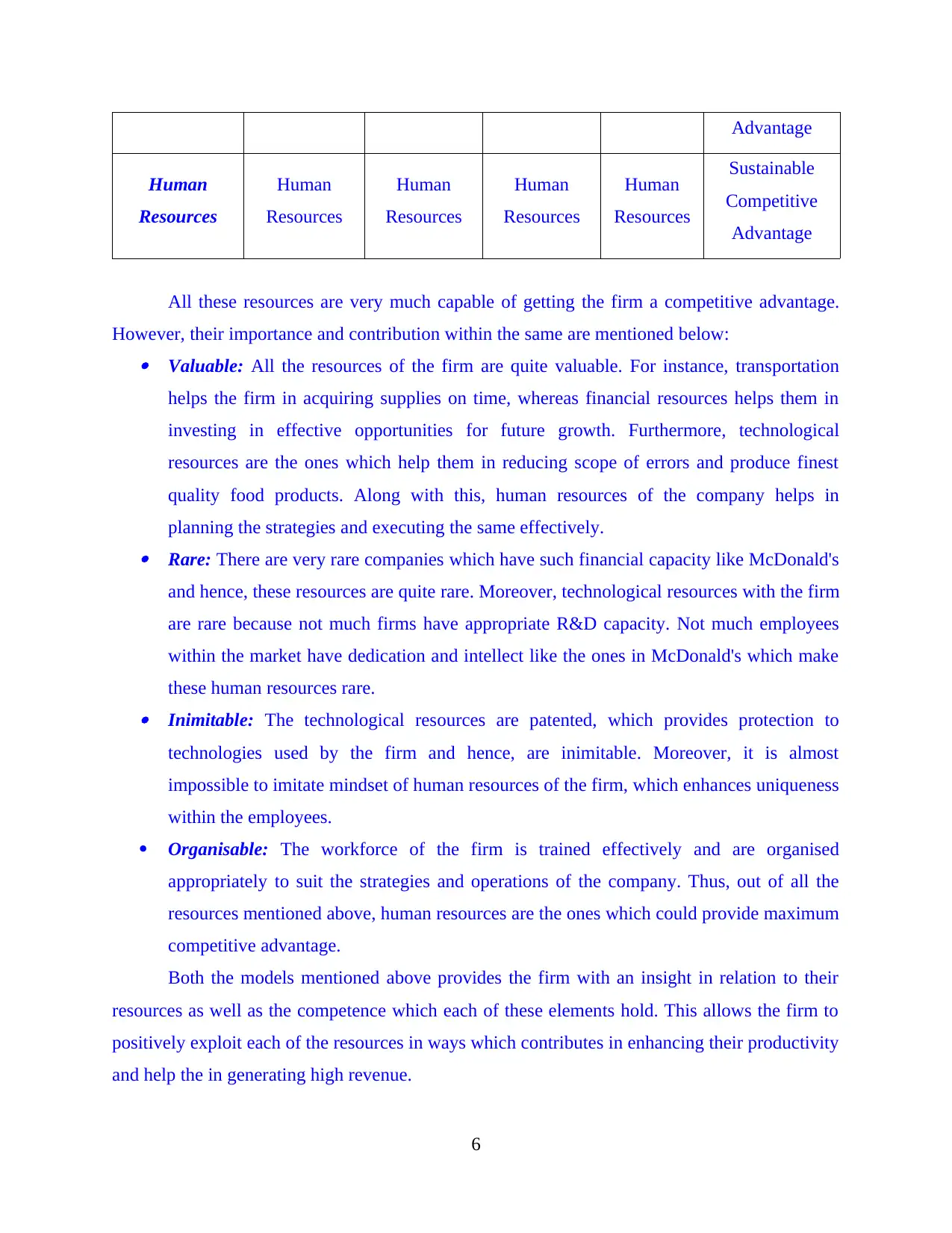
Advantage
Human
Resources
Human
Resources
Human
Resources
Human
Resources
Human
Resources
Sustainable
Competitive
Advantage
All these resources are very much capable of getting the firm a competitive advantage.
However, their importance and contribution within the same are mentioned below: Valuable: All the resources of the firm are quite valuable. For instance, transportation
helps the firm in acquiring supplies on time, whereas financial resources helps them in
investing in effective opportunities for future growth. Furthermore, technological
resources are the ones which help them in reducing scope of errors and produce finest
quality food products. Along with this, human resources of the company helps in
planning the strategies and executing the same effectively. Rare: There are very rare companies which have such financial capacity like McDonald's
and hence, these resources are quite rare. Moreover, technological resources with the firm
are rare because not much firms have appropriate R&D capacity. Not much employees
within the market have dedication and intellect like the ones in McDonald's which make
these human resources rare. Inimitable: The technological resources are patented, which provides protection to
technologies used by the firm and hence, are inimitable. Moreover, it is almost
impossible to imitate mindset of human resources of the firm, which enhances uniqueness
within the employees.
Organisable: The workforce of the firm is trained effectively and are organised
appropriately to suit the strategies and operations of the company. Thus, out of all the
resources mentioned above, human resources are the ones which could provide maximum
competitive advantage.
Both the models mentioned above provides the firm with an insight in relation to their
resources as well as the competence which each of these elements hold. This allows the firm to
positively exploit each of the resources in ways which contributes in enhancing their productivity
and help the in generating high revenue.
6
Human
Resources
Human
Resources
Human
Resources
Human
Resources
Human
Resources
Sustainable
Competitive
Advantage
All these resources are very much capable of getting the firm a competitive advantage.
However, their importance and contribution within the same are mentioned below: Valuable: All the resources of the firm are quite valuable. For instance, transportation
helps the firm in acquiring supplies on time, whereas financial resources helps them in
investing in effective opportunities for future growth. Furthermore, technological
resources are the ones which help them in reducing scope of errors and produce finest
quality food products. Along with this, human resources of the company helps in
planning the strategies and executing the same effectively. Rare: There are very rare companies which have such financial capacity like McDonald's
and hence, these resources are quite rare. Moreover, technological resources with the firm
are rare because not much firms have appropriate R&D capacity. Not much employees
within the market have dedication and intellect like the ones in McDonald's which make
these human resources rare. Inimitable: The technological resources are patented, which provides protection to
technologies used by the firm and hence, are inimitable. Moreover, it is almost
impossible to imitate mindset of human resources of the firm, which enhances uniqueness
within the employees.
Organisable: The workforce of the firm is trained effectively and are organised
appropriately to suit the strategies and operations of the company. Thus, out of all the
resources mentioned above, human resources are the ones which could provide maximum
competitive advantage.
Both the models mentioned above provides the firm with an insight in relation to their
resources as well as the competence which each of these elements hold. This allows the firm to
positively exploit each of the resources in ways which contributes in enhancing their productivity
and help the in generating high revenue.
6
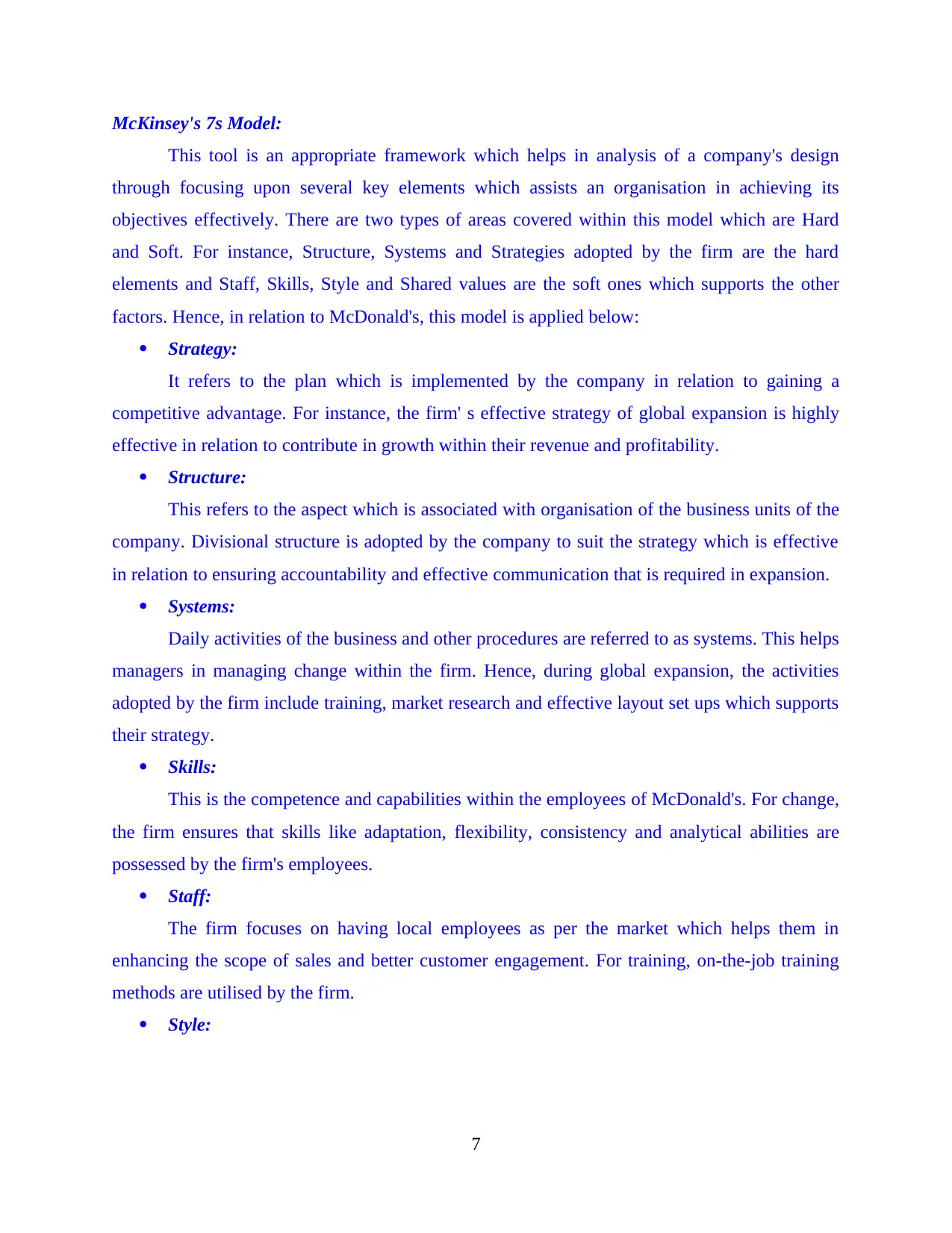
McKinsey's 7s Model:
This tool is an appropriate framework which helps in analysis of a company's design
through focusing upon several key elements which assists an organisation in achieving its
objectives effectively. There are two types of areas covered within this model which are Hard
and Soft. For instance, Structure, Systems and Strategies adopted by the firm are the hard
elements and Staff, Skills, Style and Shared values are the soft ones which supports the other
factors. Hence, in relation to McDonald's, this model is applied below:
Strategy:
It refers to the plan which is implemented by the company in relation to gaining a
competitive advantage. For instance, the firm' s effective strategy of global expansion is highly
effective in relation to contribute in growth within their revenue and profitability.
Structure:
This refers to the aspect which is associated with organisation of the business units of the
company. Divisional structure is adopted by the company to suit the strategy which is effective
in relation to ensuring accountability and effective communication that is required in expansion.
Systems:
Daily activities of the business and other procedures are referred to as systems. This helps
managers in managing change within the firm. Hence, during global expansion, the activities
adopted by the firm include training, market research and effective layout set ups which supports
their strategy.
Skills:
This is the competence and capabilities within the employees of McDonald's. For change,
the firm ensures that skills like adaptation, flexibility, consistency and analytical abilities are
possessed by the firm's employees.
Staff:
The firm focuses on having local employees as per the market which helps them in
enhancing the scope of sales and better customer engagement. For training, on-the-job training
methods are utilised by the firm.
Style:
7
This tool is an appropriate framework which helps in analysis of a company's design
through focusing upon several key elements which assists an organisation in achieving its
objectives effectively. There are two types of areas covered within this model which are Hard
and Soft. For instance, Structure, Systems and Strategies adopted by the firm are the hard
elements and Staff, Skills, Style and Shared values are the soft ones which supports the other
factors. Hence, in relation to McDonald's, this model is applied below:
Strategy:
It refers to the plan which is implemented by the company in relation to gaining a
competitive advantage. For instance, the firm' s effective strategy of global expansion is highly
effective in relation to contribute in growth within their revenue and profitability.
Structure:
This refers to the aspect which is associated with organisation of the business units of the
company. Divisional structure is adopted by the company to suit the strategy which is effective
in relation to ensuring accountability and effective communication that is required in expansion.
Systems:
Daily activities of the business and other procedures are referred to as systems. This helps
managers in managing change within the firm. Hence, during global expansion, the activities
adopted by the firm include training, market research and effective layout set ups which supports
their strategy.
Skills:
This is the competence and capabilities within the employees of McDonald's. For change,
the firm ensures that skills like adaptation, flexibility, consistency and analytical abilities are
possessed by the firm's employees.
Staff:
The firm focuses on having local employees as per the market which helps them in
enhancing the scope of sales and better customer engagement. For training, on-the-job training
methods are utilised by the firm.
Style:
7
⊘ This is a preview!⊘
Do you want full access?
Subscribe today to unlock all pages.

Trusted by 1+ million students worldwide
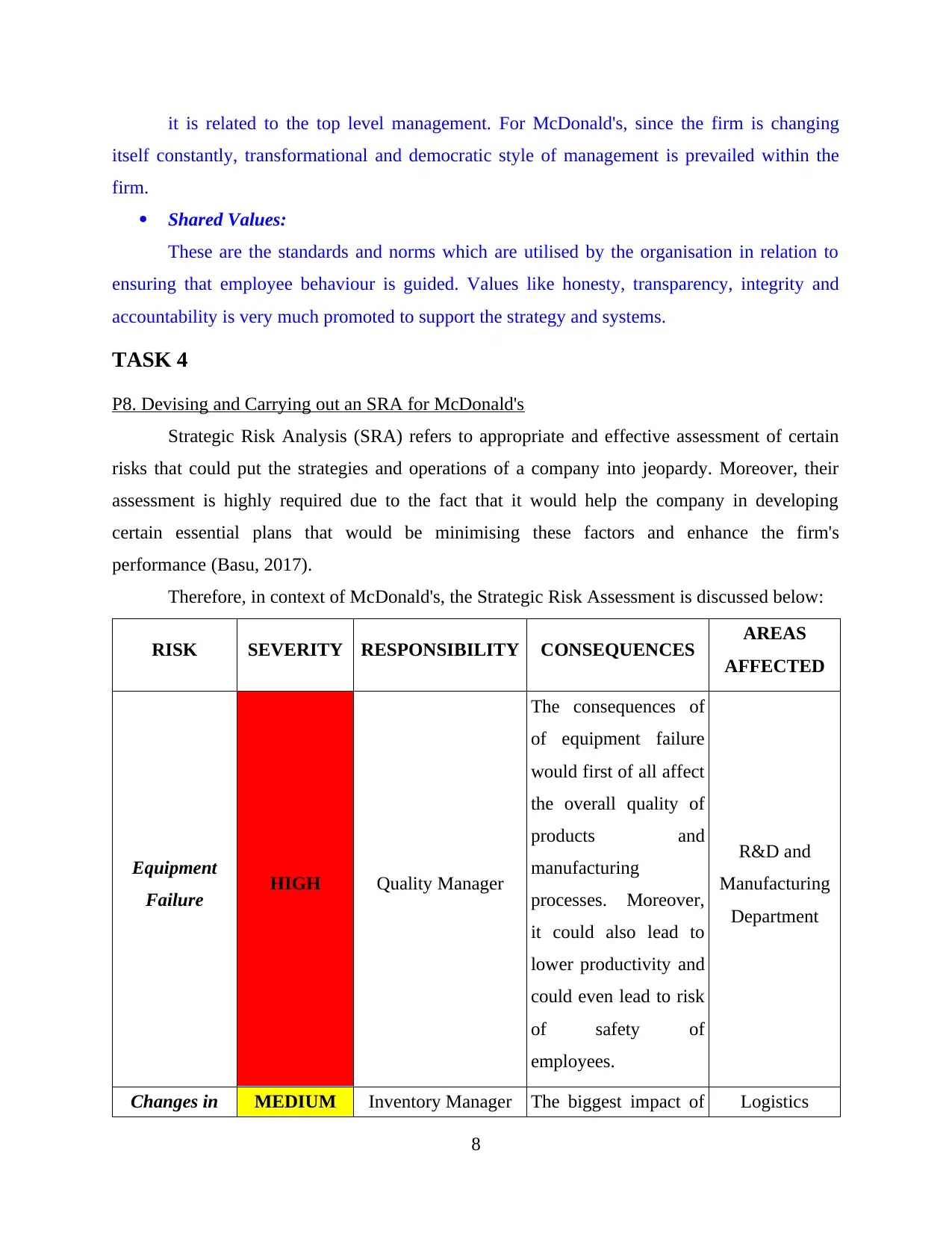
it is related to the top level management. For McDonald's, since the firm is changing
itself constantly, transformational and democratic style of management is prevailed within the
firm.
Shared Values:
These are the standards and norms which are utilised by the organisation in relation to
ensuring that employee behaviour is guided. Values like honesty, transparency, integrity and
accountability is very much promoted to support the strategy and systems.
TASK 4
P8. Devising and Carrying out an SRA for McDonald's
Strategic Risk Analysis (SRA) refers to appropriate and effective assessment of certain
risks that could put the strategies and operations of a company into jeopardy. Moreover, their
assessment is highly required due to the fact that it would help the company in developing
certain essential plans that would be minimising these factors and enhance the firm's
performance (Basu, 2017).
Therefore, in context of McDonald's, the Strategic Risk Assessment is discussed below:
RISK SEVERITY RESPONSIBILITY CONSEQUENCES AREAS
AFFECTED
Equipment
Failure HIGH Quality Manager
The consequences of
of equipment failure
would first of all affect
the overall quality of
products and
manufacturing
processes. Moreover,
it could also lead to
lower productivity and
could even lead to risk
of safety of
employees.
R&D and
Manufacturing
Department
Changes in MEDIUM Inventory Manager The biggest impact of Logistics
8
itself constantly, transformational and democratic style of management is prevailed within the
firm.
Shared Values:
These are the standards and norms which are utilised by the organisation in relation to
ensuring that employee behaviour is guided. Values like honesty, transparency, integrity and
accountability is very much promoted to support the strategy and systems.
TASK 4
P8. Devising and Carrying out an SRA for McDonald's
Strategic Risk Analysis (SRA) refers to appropriate and effective assessment of certain
risks that could put the strategies and operations of a company into jeopardy. Moreover, their
assessment is highly required due to the fact that it would help the company in developing
certain essential plans that would be minimising these factors and enhance the firm's
performance (Basu, 2017).
Therefore, in context of McDonald's, the Strategic Risk Assessment is discussed below:
RISK SEVERITY RESPONSIBILITY CONSEQUENCES AREAS
AFFECTED
Equipment
Failure HIGH Quality Manager
The consequences of
of equipment failure
would first of all affect
the overall quality of
products and
manufacturing
processes. Moreover,
it could also lead to
lower productivity and
could even lead to risk
of safety of
employees.
R&D and
Manufacturing
Department
Changes in MEDIUM Inventory Manager The biggest impact of Logistics
8
Paraphrase This Document
Need a fresh take? Get an instant paraphrase of this document with our AI Paraphraser
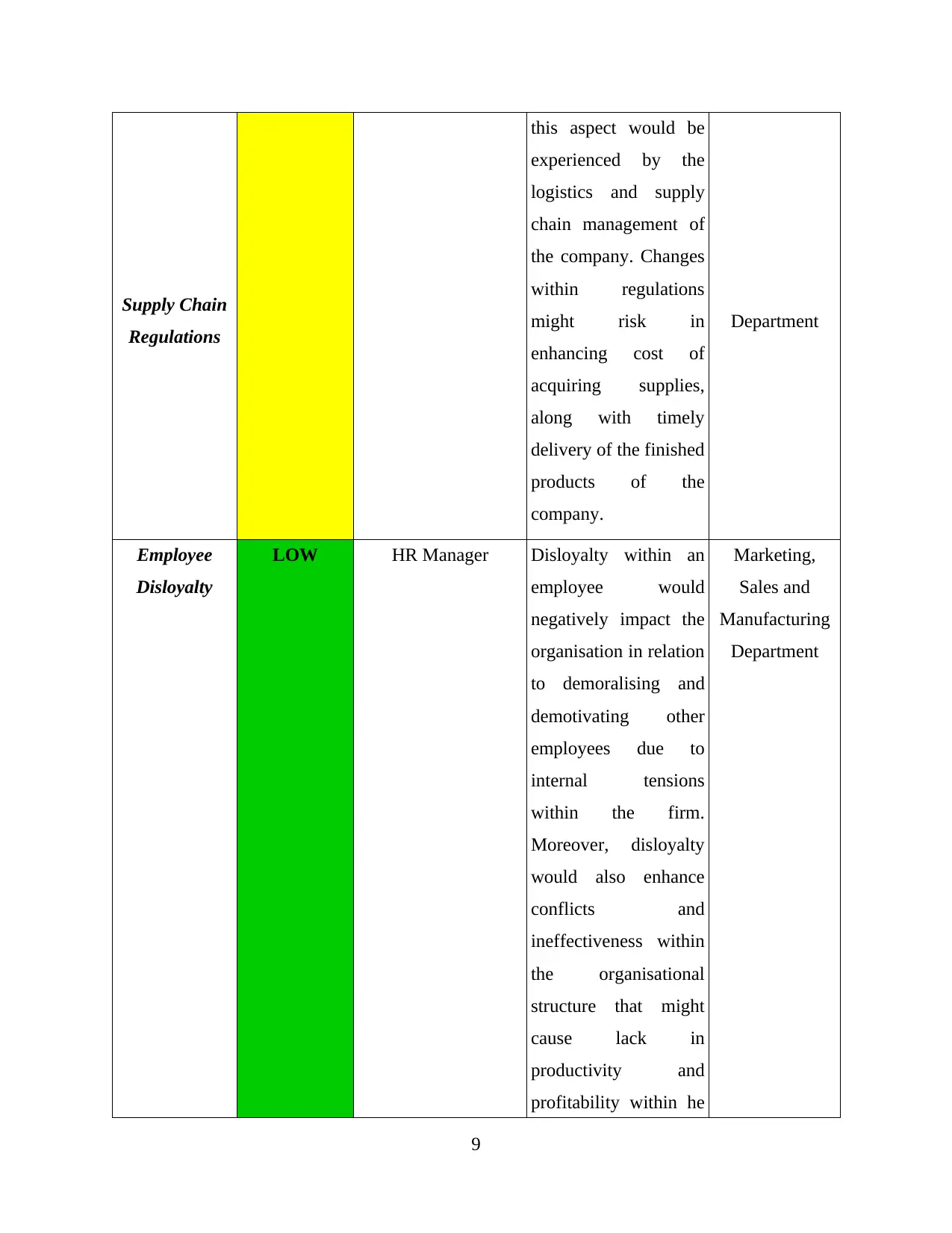
Supply Chain
Regulations
this aspect would be
experienced by the
logistics and supply
chain management of
the company. Changes
within regulations
might risk in
enhancing cost of
acquiring supplies,
along with timely
delivery of the finished
products of the
company.
Department
Employee
Disloyalty
LOW HR Manager Disloyalty within an
employee would
negatively impact the
organisation in relation
to demoralising and
demotivating other
employees due to
internal tensions
within the firm.
Moreover, disloyalty
would also enhance
conflicts and
ineffectiveness within
the organisational
structure that might
cause lack in
productivity and
profitability within he
Marketing,
Sales and
Manufacturing
Department
9
Regulations
this aspect would be
experienced by the
logistics and supply
chain management of
the company. Changes
within regulations
might risk in
enhancing cost of
acquiring supplies,
along with timely
delivery of the finished
products of the
company.
Department
Employee
Disloyalty
LOW HR Manager Disloyalty within an
employee would
negatively impact the
organisation in relation
to demoralising and
demotivating other
employees due to
internal tensions
within the firm.
Moreover, disloyalty
would also enhance
conflicts and
ineffectiveness within
the organisational
structure that might
cause lack in
productivity and
profitability within he
Marketing,
Sales and
Manufacturing
Department
9

firm.
All the risks mentioned above could have severe disadvantages to the company and its
performance. Moreover, it could also cause complexities when it comes to accomplishment of
the operational requirements of the organisation. In addition to this, the strategies and functions
of McDonald's could also experience a setback in achieving a competitive advantage and
sustainability within the organisation (Munjal, Requejo, and Kundu, 2019).
Contingency Plans:
However, for a company like McDonald's, it is highly essential that several contingency
plans are very well formulated, as well as implemented within the organisation, which assists the
company in handling, managing and minimising the risk associated with the functions of the firm
effectively. Hence, for McDonald's, the contingency plan is analysed below:
RISK STRATEGIES / ACTIONS PERSON IN-
CHARGE TIME FRAME
Equipment Failure
In order to appropriately address
the risk of equipment failure, the
organisation could implement
in-house testing which would
help the firm in enhancing the
scope of higher performance by
the tools and equipments of the
company.
Quality
Improvement
Manager
2 Months
Changes in Supply
Chain Regulations
The firm must develop effective
relations from the supply chain
of the company, which will not
be experiencing negative impact
at times of changes in
regulation. Moreover, suppliers
would also be formulated on
contractual basis which would
Public Relations
Manager
6 Months
10
All the risks mentioned above could have severe disadvantages to the company and its
performance. Moreover, it could also cause complexities when it comes to accomplishment of
the operational requirements of the organisation. In addition to this, the strategies and functions
of McDonald's could also experience a setback in achieving a competitive advantage and
sustainability within the organisation (Munjal, Requejo, and Kundu, 2019).
Contingency Plans:
However, for a company like McDonald's, it is highly essential that several contingency
plans are very well formulated, as well as implemented within the organisation, which assists the
company in handling, managing and minimising the risk associated with the functions of the firm
effectively. Hence, for McDonald's, the contingency plan is analysed below:
RISK STRATEGIES / ACTIONS PERSON IN-
CHARGE TIME FRAME
Equipment Failure
In order to appropriately address
the risk of equipment failure, the
organisation could implement
in-house testing which would
help the firm in enhancing the
scope of higher performance by
the tools and equipments of the
company.
Quality
Improvement
Manager
2 Months
Changes in Supply
Chain Regulations
The firm must develop effective
relations from the supply chain
of the company, which will not
be experiencing negative impact
at times of changes in
regulation. Moreover, suppliers
would also be formulated on
contractual basis which would
Public Relations
Manager
6 Months
10
⊘ This is a preview!⊘
Do you want full access?
Subscribe today to unlock all pages.

Trusted by 1+ million students worldwide
1 out of 16
Related Documents
Your All-in-One AI-Powered Toolkit for Academic Success.
+13062052269
info@desklib.com
Available 24*7 on WhatsApp / Email
![[object Object]](/_next/static/media/star-bottom.7253800d.svg)
Unlock your academic potential
Copyright © 2020–2025 A2Z Services. All Rights Reserved. Developed and managed by ZUCOL.




